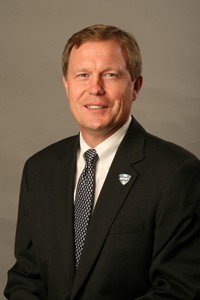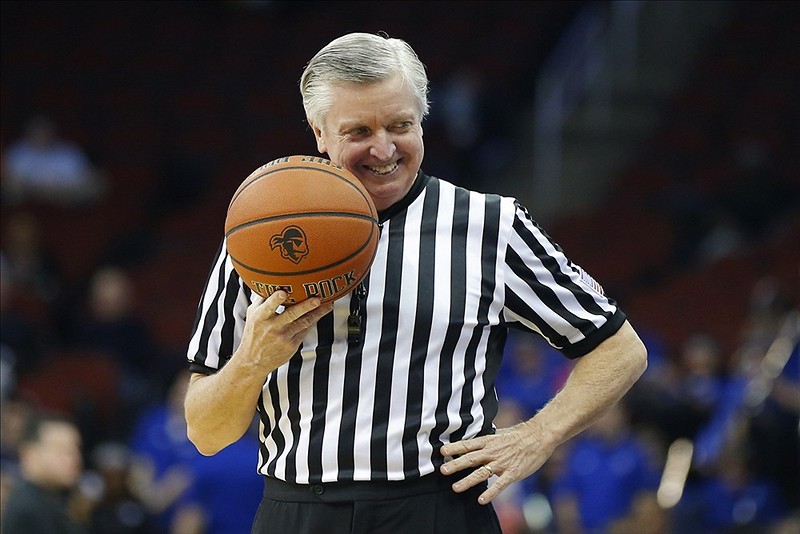The NCAA released comments recently from Joseph R. Castiglione, (pictured below) Oklahoma athletic director and chair of the Division I Men’s Basketball Committee, about remarkable statistical trends favoring the rules changes made after last season.
“The statistical trends show progress has been made,” Castiglione states. “There is a long way to go, but we knew from the beginning this was going to be a process that would take many years to develop the desired consistency we need to achieve.”
 Scoring is up across the board at 5.34 points more per game from this point a season ago. The five seconds less on the shot clock is working as planned. Slightly more fouls are being called to alleviate the physical play that was making the game turn ugly.
Scoring is up across the board at 5.34 points more per game from this point a season ago. The five seconds less on the shot clock is working as planned. Slightly more fouls are being called to alleviate the physical play that was making the game turn ugly.
That’s great news. The real story behind this improvement is the fact that the NCAA adopted the rule changes in the first place. The shot clock was not altered for 22 long years since it was reduced from 45 seconds to 35 way back in 1993, before most of today’s players were born.
This is definitely not your father’s NCAA. The governing body was an easy target in the past for being like a dictatorship – cold, heartless and stubborn, set in their ways. Changes took a long time to be made, if they were made at all. The NCAA now gets it. Change is for the good.
Ultimately responsible for the rules changes made to increase the pace of the game is the NCAA Men’s Basketball Rules Committee, formerly chaired by Belmont basketball coach Rick Byrd. The committee’s recommendations to adopt the new rules were approved by the NCAA Playing Rules Oversight Panel, which includes 12 members, six from Division I and three representatives each from Division II and III.
Pac-12 commissioner Larry Scott, one of the more forward-thinking commissioners in the nation, is thankfully a member of the panel along with five other commissioners. One of those commissioners, Jon Steinbrecher of the Mid-American Conference (pictured right), serves as the panel’s chair.
Also part of the NCAA Playing Rules Oversight Panel are two senior women administrators – Shelley Appelbaum of Michigan State and Denta Radcliffe of Alabama-Birmingham. A sports information director, Truman State’s Kevin White, serves on the panel as does a faculty lecturer, Lynn Oberbillig of Smith College.
Two athletic directors from lower divisions, Sonoma State’s William Fusco and Shenandoah’s Doug Zipp, are also part of the panel whom we can thank for minimizing the shot clock from 35 seconds to 30, among other things.
Referees are calling more fouls on hand checking especially on perimeter ball handlers. They are cleaning up the physicality in the post area and calling for fouls on moving screens.
Play is stopped less because teams also have one fewer team timeout (only three can carry over instead of four) in the second half. A coach can no longer call a timeout when the ball is live. Even the amount of time allotted to replace a player who fouled out was reduced from 20 to 15 seconds.
The game was becoming more unwatchable before the changes finally took place. Scoring in men’s college basketball hit an all-time low in 2012-13 when teams averaged 67.5 points per game. Last season, teams fared only a fraction of a point better at 67.6 points per game.
Compared to this point of the 2014-15 season, scoring is up 5.42 points per game, from 67.64 to 73.06. In conference games only, teams are averaging 72.3 points per game, up 5.26 points per game from the same point of the conference season last year.
Most interesting of the NCAA Men’s Basketball Rules Committee is that is comprised mostly of non-Power 5 or Division I representation. The new chair is Akron coach Keith Dambrot. The only recognizable names or institutions for mainstream college basketball followers that are part of the committee are Georgia coach Mark Fox and Big East senior associate commissioner Stu Jackson.
Nothing is wrong with the fact that administrators from institutions such as Hillsdale College, Erksine College and State University of New York at Cobleskill are part of the basketball rules committee who decide rules that could impact the way Kentucky’s John Calipari, Duke’s Mike Krzyzewski and Kansas’ Bill Self, etc., coach their personnel.
The committee is void of special interests and influences. Can you imagine if the rules committee was comprised of a majority of Power 5 athletic directors and head coaches? It would be a case of who is looking out for whom instead of making the right decisions to make the entire game better.
The proper checks and balances and unbiased viewpoint of the current makeup of the rules committee and oversight panel worked with the recent rules changes. They oversight panel, for example, embodied the characteristic of Scott by thinking ahead for what is best for the game, not for a select group of programs.
The more attractive the product, the more opportunities for television exposure and revenue and increased attendance and money at the gate. Make no mistake, the financial aspect is the bottom line that spurred the changes into a making college basketball a more watchable product.
Thanks to the NCAA finally willing to change the way games are called, and reduce the shot clock to 30 seconds (someday it will probably reach 24 seconds like the NBA), college basketball is becoming fun to watch again. Not all of the coaches of major programs might agree with that assessment, but what matters most is impartial administrators from universities such as Long Island-Brooklyn of LaVerne, who are part of the rules committee, came to an agreement to make it happen.


Leave a Reply
You must be logged in to post a comment.